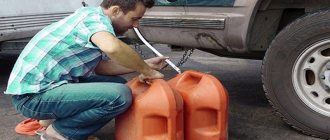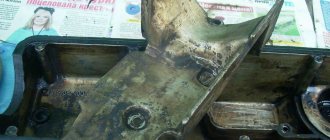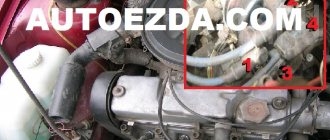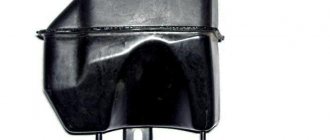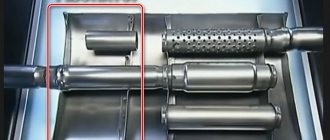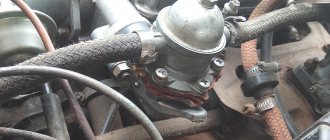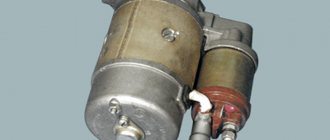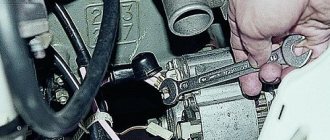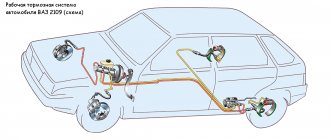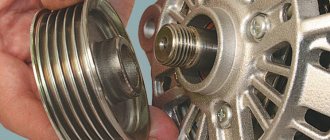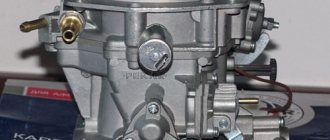Answers (2)
The gas tank of a VAZ 2109 with any engines (1.1, 1.3, 1.5) holds 43 liters of fuel, as indicated in the vehicle’s passport specifications. In fact, very few people pour exactly that much.
fuel tank vaz 2109
Personally, I filled my nine with 47 liters up to the throat. Yes, I know, gas stations don’t top up horribly, but I didn’t come with a dry tank either. I was driving along the highway, there were about 5-7 liters left in the tank, the light just came on. Refueling "Ga...m". Don’t think that it’s “g..but”. But I don’t want to advertise and scold. In general, after 2.5 years of operation, I settled on the figure of 50 liters to the throat.
Many VAZ 2108 2109 21099 owners are interested in how much gasoline can be put in the tank? The operating instructions say 43 liters, but this does not take into account the filler neck. If you fill it until it overflows, you can squeeze in 46-47 liters of gasoline. It would seem 3-4 liters on top, but when driving on the highway, the power reserve immediately increases by 40-50 kilometers. However, it is easy to fill a full tank from a canister, and at a gas station there will be a problem with the pistol snapping off. The first click will not yet reach 40 liters in the tank. The sensor in the gun is triggered by drops, vapors and foam of gasoline, and at different gas stations it will behave differently due to different fuel pressure, a different type of sensor, etc. To fill it to the top, you need to stick the gun out a little and pour in a thin stream, lightly pressing the tongue. This method has one disadvantage for the driver: if fuel consumption is low when refueling, the automatic machine considers it to be more than it actually is. Therefore, when the driver drains the last 4 liters (as shown on the column display) in a thin stream, 3.5 liters actually enter the tank.
Some drivers, on the contrary, delay the moment of refueling until the last minute. They drive with the light on until there are literally a couple of liters of gasoline left in the tank. Such driving is not very useful for the car for the following reasons:
- When temperatures change, condensation forms on the walls of the gas tank, which flows down the walls and settles to the bottom of the gas tank, partially mixing with gasoline. Naturally, it is not good for an engine to run on gasoline mixed with water.
- Fuel pumps of injection engines are located in the gas tank and for their normal and reliable operation, at least 5 liters of gasoline are required in the tank. Otherwise, on potholes, turns, and slopes, the pump begins to grab air, which can cause it to fail.
Restyling
Most Russians prefer domestic cars to foreign cars, and most of the models were produced a long time ago.
Among modern cars - VAZ-2109. But the vehicle is both technically and morally outdated. Restyling will help give the car a second life.
Many people are interested in where to start. All Russian cars, regardless of the year of manufacture, have a common problem - the level of sound insulation.
This does not apply to those who like to drive slowly, but there are vehicles that accelerate to 90 km/h and above; you have to shout so that the passengers sitting behind can hear the driver.
Dashboard. The next level is advanced car restyling. In this case, the most dramatic changes to the car are coming.
1 — air release hose; 2 — separator hose; 3 - filling pipe hose
First, disconnect the wire from the “–” terminal of the battery.
NOTE! It is recommended to have an assistant remove the fuel tank.
- Fold back the rear seat cushion and unscrew the cut-out part of the sound insulation.
- Unscrew the two screws securing the hatch cover.
- Remove the hatch cover with the rubber gasket.
- Disconnect the block with wires from the fuel level sensor.
- Unscrew the nut securing the sensor, under which the ground wire is secured.
- Remove the wire from the stud.
The remaining operations are carried out under the bottom of the car.
↑ Clamps and hoses
- Loosen the clamp.
- Disconnect the hose from the filler pipe.
- Loosen the clamp and disconnect the air release hose from the fitting on the fuel tank.
- Loosen the clamp and disconnect the separator hose from the fitting on the fuel tank.
- Loosen the clamps and disconnect the hoses from the fuel lines.
- Holding the tank, unscrew the two bolts of the tank mounting clamps.
- Pull the clamps down while supporting the tank. Bend the clamp on the left side behind the resonator pipe.
↑ Removing the fuel tank from the car
- Lower the front end of the tank down and remove it from the vehicle. Drain any remaining gasoline from the tank.
- Unscrew the five remaining sensor mounting nuts and remove the fuel gauge sensor from the tank.
- Remove the sensor gasket.
↑ Diagnostics and repair of the fuel tank
- Inspect the tank along the line where the upper and lower parts meet.
- If you find a leak, pour out the remaining gasoline, thoroughly rinse and dry the tank. Then solder the leak with soft solder.
- If necessary, glue the torn rubber gaskets on the tank.
You can solder only a thoroughly washed tank that does not contain gasoline vapors. Otherwise, when soldering, the vapors may ignite.
To wash the fuel tank, use detergents: “Labomid”, “MS” or “ML”.
To remove any remaining detergent, rinse and steam the tank with hot water. Dry the tank thoroughly.
↑ Checking the sensor
Connect an ohmmeter to the sensor contacts and check the sensor resistance at three float positions:
- in the lowest position (empty tank) the resistance should be 315 - 345 Ohms,
- in the middle position (tank half full) – 108–128 Ohm,
- in the uppermost position (full tank) – no more than 7 Ohms.
If the resistance is different from the specified value, replace the sensor.
↑ Filter and float
Wash the dirty filter. Shake the float. If there is gasoline in it, then the float is leaking. We recommend replacing the float.
Description of the design [edit | edit code ]
The body of the VAZ-2109 is two-volume, hatchback
[2]. The front suspension of the VAZ-2109 is completely independent, MacPherson type. The rear suspension is semi-independent with a torsional transverse beam, similar in design to many other front-wheel drive cars of those years. The VAZ-2109 was equipped with a manual transmission, which included:
- single disc simple clutch;
- five-speed gearbox;
- cylindrical main gear;
- bevel differential;
- drive shafts with CV joints [2] .
Actual tank volume on the 14th model
As mentioned, the manufacturer claims that the volume of the 2114 tank is 43 liters (in some cases you can find a figure of 42.5 liters). And this figure is indeed very close to reality.
At the same time, it is worth considering a number of facts that can significantly affect capacity:
- Errors in the manufacture of the tank.
- Time of year and temperature.
- Fuel system volume.
The first of these factors is usually insignificant. But, as practice shows, sometimes the difference in the volumes of two identical tanks can reach (as a result of low production accuracy) 2 liters. Thus, on some machines the total volume can reach 45 liters (which is extremely rare).
This should also include the difference in weather conditions. In cold weather, the fuel contracts, and in warm weather, it expands. This factor also affects how many liters the tank on a VAZ 2114 can hold (if we take into account the full volume of gasoline that can fit in hot summers and winter frosts, the difference can reach 1.5 liters).
Well, finally, you should remember that the fuel system itself also holds a certain amount of fuel. On average, when the tank is completely empty, up to 2 liters of gasoline can remain in it. As a result of this number of features, the amount of fuel contained in the tank may differ from that declared by the manufacturer, either more or less.
If at a gas station you managed to fill 50 liters of fuel into an almost empty tank, then this can become a good reason to complain about the accuracy of the filling device and the operation of the station itself. Such a large difference in volumes cannot be attributed to any of the above errors.
It is also worth noting that if the vehicle is operated incorrectly and refueled with low-quality fuel, sediment can accumulate at the bottom of the tank, which over time can (albeit insignificantly) reduce its volume. In order to avoid such a situation, the tank should be inspected every few years.
If the warning light on the panel lights up, it means you can fill the tank with up to 35 liters of fuel without fear of it overflowing.
Technical characteristics of VAZ 2109
Car modifications Start of production: January 1987 End of production: January 1997 Body: 5 doors. hatchback Engine type: L4 Fuel grade: AI-95 Engine capacity, cu. see: 1300 Engine capacity, l.: 1.3 Valves per cylinder: 2 Power, hp: 64 Achieved at rpm. in min.: 5600 Torque, Nm/rev. in min.:95 / 3400Maximum speed, km/h:148Acceleration time to 100 km/h, sec.:16Fuel consumption (combined cycle), l. per 100 km: Fuel consumption (in the city), l. per 100 km: Fuel consumption (outside the city), l. per 100 km: 5.4 Engine layout: front, transverse Power system: carburetor Gas distribution system: overhead valve with overhead camshaft Cylinder diameter, mm: Piston stroke, mm: CO2 exhaust, g/km: Compression ratio: Drive type: Front Gearbox: manual transmission Number of stages :Front suspension:Rear suspension:trailing armFront brakes:discRear brakes:drumLength, mm:4006Width, mm:1650Height, mm:1402Wheelbase, mm:2460Front wheel track, mm:1400Rear wheel track, mm:1370Number of seats:5Tire size:165 /70 R13 Curb weight, kg: 915 Permissible weight, kg: 1340 Trunk volume, l: Fuel tank volume, l: 43 Turning circle, m: Warranty against corrosion, years: Vehicle modifications Start of production: January 1987 End of production: January 2004 Body: 5 doors. hatchback Engine type: L4 Fuel grade: AI-95 Engine capacity, cu. see: 1308 Engine capacity, l.: 1.3 Valves per cylinder: 2 Power, hp: 140 Achieved at rpm. in min.: 6000 Torque, Nm/rev. in min.: 186 / 4500 Maximum speed, km/h: 190 Acceleration time to 100 km/h, sec.: 9 Fuel consumption (combined cycle), l. per 100 km: 10 Fuel consumption (in the city), l. per 100 km: 12.5 Fuel consumption (outside the city), l. per 100 km: 7 Engine layout: front, transverse Power system: rotary piston Gas distribution system: overhead valve with overhead camshaft Cylinder diameter, mm: Piston stroke, mm: CO2 exhaust, g/km: Compression ratio: Drive type: Front Gearbox: manual transmission Quantity steps: Front suspension: Rear suspension: trailing arm, coil spring, telescopic shock absorber Front brakes: disc Rear brakes: drum Length, mm: 4006 Width, mm: 1650 Height, mm: 1402 Wheelbase, mm: 2460 Wheel track front, mm: 1400 Wheel track rear, mm: 1370 Number of seats: 5 Tire size: 175/70 R13 Curb weight, kg: 1040 Permissible weight, kg: 1465 Trunk volume, l: Fuel tank volume, l: 43 Turning circle, m: Corrosion warranty, years:Basic gas tank malfunctions
The gas tank is made of strong, durable material and lasts for the entire life of the vehicle. However, in some situations it may require repair. These situations are as follows.
- Fuel line clogged.
Hole in the tank.
Leak on the welding line of the tank body.
The cause of clogged hoses can be dirt getting into the fuel mesh in the tank itself. The solution in this case is quite simple - periodically wash or change this mesh.
If a hole is formed in the tank as a result of a mechanical shock, then it can no longer be repaired. In this case, the tank will need to be replaced.
If gasoline leaks from the welding line of the tank halves, you can try to seal this place. However, this procedure is very complex and requires appropriate experience.
A gas tank with extensive corrosion cannot be repaired.
Consumption and travel distance
If we take into account the volume of the VAZ 2114 tank and the data on gasoline consumption (given in the table above), we can draw the following conclusions about the possible travel range.
When driving at a constant speed of 90 km/h, the maximum range can be almost 700 km without additional refueling.
When traveling in the so-called “mixed” city/highway mode, consumption will increase, which means the range will decrease (up to 640 km).
And when traveling only in city mode (taking into account standing in traffic jams and a large proportion of driving in low gears), fuel consumption will be maximum - almost 10 l/100 km. It is also worth considering that these figures are for new cars. For used cars they will be slightly higher.
Autonomous mileage after switching to gas
Autonomous mileage 2109 with gas equipment
| Volume | Transfers | Cylinder capacity | Refilling the cylinder | Total autonomous mileage | ||
| Around town | On the road | Mixed | ||||
| 1.1 | Mechanics | 47 l. | ||||
| 1.3 | Mechanics | 47 l. | ||||
| 1.5 | Mechanics | 47 l. | ||||
| 1.5 | Mechanics | 47 l. | ||||
| Price per liter of gas in calculations: CIS - 18.61 ₽. | ||||||
HBO doubles the autonomous mileage of the VAZ 2109 1987...2006 hatchback. Now there is definitely enough fuel for the longest trips.
Call to ask questions, consult with a specialist or sign up for installation in Moscow (24 hours a day) or write to [email protected]
Certified multi-brand center for installation, maintenance and repair of gas equipment:
Gas Performance Benefits
IN COMBINATION, THESE FACTORS EXTEND THE ENGINE LIFE BY
Gas extends the life of oil and spark plugs and reduces vehicle maintenance costs.
Gas burns a little slower than gasoline, which reduces the load on the piston group and crankshaft, causing the engine to run smoother.
The gas mixes easily with air and fills the cylinders more evenly with a homogeneous mixture, so the engine runs smoother and quieter. The gas mixture burns almost completely, so no carbon deposits form in the pistons, valves and spark plugs.
The octane number of petroleum gas is 103-105, which virtually eliminates detonation of engine parts. This advantage of gas can be especially important for engines with a high compression ratio that consume high-octane (and therefore expensive) gasoline.
